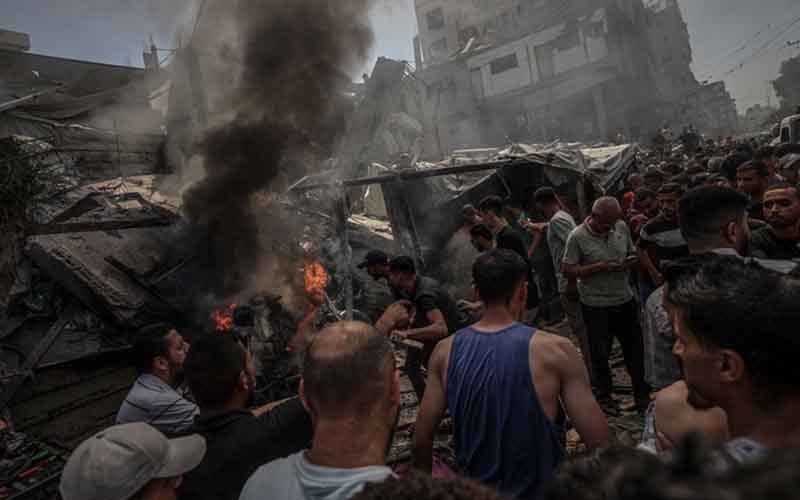At least 68 Palestinians were killed in a series of Israeli airstrikes and gunfire incidents across the Gaza Strip on Tuesday, including 56 civilians who were reportedly waiting near aid distribution points, according to Gaza’s civil defence agency.
Spokesman Mahmud Bassal told AFP that the attacks targeted densely populated aid collection zones in Khan Yunis, Zikim, and central Gaza — sites where thousands have been gathering daily amid a worsening humanitarian crisis.
Targeting the Vulnerable
Among the dead, 30 people were killed near Khan Yunis, in the southern Gaza Strip, where they had assembled for food distribution. Bassal said the victims were hit by Israeli gunfire as they waited along the Morag corridor, an area controlled by Israeli forces.
The Israeli army, in response to AFP queries, acknowledged that troops had “fired warning shots” toward a “gathering of Gazans advancing” in that zone but claimed they were “not aware of any casualties as a result.”
However, Bassal reported 20 additional deaths and over 100 injuries near the Zikim border crossing in northern Gaza, another aid entry point that has seen recent convoys allowed through under international pressure. AFP journalists confirmed that at least a dozen bodies were brought to Hamad Hospital in northern Gaza following the incident.
Six more people were reportedly killed and 21 injured in central Gaza, again while waiting near a food distribution site. The Israeli military denied firing near any such locations in central Gaza on Tuesday, prompting further dispute over accountability.
The rising toll underscores an emerging and grim pattern: aid lines — once considered lifelines — have increasingly become deadly frontlines.
‘No Place Is Safe’
Adding to the toll, a predawn Israeli airstrike hit a tent in Al-Mawasi, a coastal strip previously designated as a humanitarian “safe zone” by Israel. Five people died, including family members of 30-year-old Adham Younes, who condemned the contradiction of Israeli claims.
“It’s said to be a green zone and it’s safe, but it’s not,” said Younes. “They also say that the aid [distribution] is safe, but people die while obtaining aid… There’s no safety within the Gaza Strip. Everyone is exposed to death.”
His relative, Mahmud Younes, who witnessed the attack, told AFP: “We found women screaming — they were covered in blood. The entire family has been injured.”
Further strikes reportedly claimed six more lives near Gaza City and another civilian near Khan Yunis, according to civil defence sources.
Escalating Clashes and Denials
In a separate development, the Ezzedine al-Qassam Brigades, the armed wing of Hamas, claimed to have launched rockets at an Israeli command post in the Morag corridor. The Israeli army, however, stated it had no record of such an attack occurring.
The competing narratives between Palestinian officials and the Israeli military highlight the difficulty of verifying battlefield developments in real time. Strict media restrictions, intermittent communications, and dangerous access conditions have limited independent reporting from many parts of Gaza.
Aid Access Under Fire
Since the war began nearly 22 months ago, Israeli restrictions on aid entry — particularly fuel, food, and medicine — have brought Gaza’s healthcare and food systems to the brink. Power shortages have paralyzed hospital generators, and malnutrition has been rising, according to international humanitarian agencies.
The Gaza Humanitarian Foundation, which is backed by both the United States and Israel, currently operates four aid points across the territory. Yet these sites have frequently come under fire — drawing international concern over the safety of civilians.
“These incidents are not isolated,” said a representative from an international NGO operating in Rafah. “When people are being killed while waiting for flour and water, it’s a clear breakdown of all humanitarian norms.”
A Bleak Outlook
Calls for an immediate ceasefire have intensified, but prospects remain dim as hostilities escalate in both intensity and geographic spread.
The United Nations Office for the Coordination of Humanitarian Affairs (OCHA) said in a statement late Tuesday that it was “gravely concerned” over repeated attacks on civilians in aid zones, noting that intentional targeting of humanitarian gathering sites could amount to a war crime.
With the death toll climbing and displaced populations growing, Tuesday’s events have reignited global debates about the limits of military conduct and the rights of civilians in conflict zones — especially in areas that have been explicitly designated as protected.


